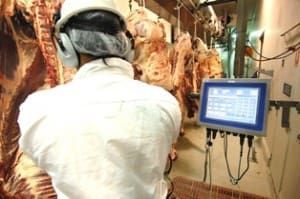AS THE long, often frenetic 2015 Eastern Australian beef kill draws to a close, attention is already starting to focus on what lies ahead for the new slaughter year starting in January.
Eastern states kills reported by the National Livestock Reporting Service are now entering their summer close-down phase, with processing numbers reflecting the early shutdowns that have taken effect since late November, with more to come.
 Queensland’s seven-day kill to Friday was back 5pc from the previous week, at 68,020 head. That’s now back 20pc on the same week last year, when many processors were operating right up to Christmas eve.
Queensland’s seven-day kill to Friday was back 5pc from the previous week, at 68,020 head. That’s now back 20pc on the same week last year, when many processors were operating right up to Christmas eve.
NSW was also back 1pc last week to 38,321 head – also 10pc back, year on year.
Three large regional fabrication sites – JBS Townsville, Teys Bilolela and Northern Cooperative Meat Co’s second chain at Casino are now shut for the year, but there is perhaps a mini surge in numbers occurring at some sites last week to tidy-up the remaining stock inventory for local suppliers.
Victoria’s kill last week was 3pc stronger, lifting to 30,624 head, while South Australia was little changed at 9269 head.
Here’s a quick summary of upcoming closure and proposed re-opening schedules for some major eastern Australian processors:
- NH Foods Oakey beef plant plans to close on December 18, re-opening (subject to rain) on Wednesday January 13. That’s probably a week longer than normal. Much of the early kill will be grain oriented, to catch up on lost time.
- JBS Dinmore closes with a last kill on Thursday December 17 (final boning shift the following day), likely returning to work with a first kill Friday 22 January, and first bone Monday 25 January. That’s 1-2 weeks longer than normal.
- JBS Rockhampton has a planned closure date this year of 18 December, and re-opening a month later on January 18, 2016.
- Bothwicks Mackay plans its last kill for today week – Tuesday 8 December – returning to work subject to rain Wednesday 27 January.
- Teys is closing its Beenleigh plant for a week between Christmas and New Year, but event that is unusual as the plant normal kills right through, holidays excepted.
- Teys Rockhampton will close on Thursday 17 December, re-opening on Monday 18, after a five-week break.
- Teys’ southern plants will kill right through, barring public holidays.
What all that suggests is that it may take longer than normal for clear pricing signals to emerge at the start of the 2016 slaughter season, due to the delayed start for many plants, and the current ragged state of export beef markets.
There’s absolutely no guarantee that early 2016 processor grids will re-open at the same rates as where they currently are, in Beef Centrals opinion. In all probability, SEQ slaughter will start lower than where they are this final killing week. Southeast Queensland grids have remained remarkably stable for the past eight or nine weeks, currently sitting on 500-505c for best cows, with four-tooth grassfed ox at 540-545c.
Granted, slaughter cattle will be shorter than even in the new year, but export market conditions have also continued to deteriorate in the past fortnight. As this morning’s companion article illustrates, the US manufacturing beef trade is still descending at a dramatic rate. Beef stock on hand in the US, Japan and elsewhere is extremely high, and international customer demand is described as ‘very flat.’
The biggest impact from the upcoming extended processor closure is that it may help take some pressure off the pipeline a little, but it’s hard to be too bullish about opening gambit grid prospects for 2016 at this stage.
Rates paid for saleyards cattle across southern and eastern Australia this week reflect the more pessimistic outlook on the export front, with processors pushing prices lower.
Early kills at some sites next year will also be dominated by grainfed cattle, as some processors manage their longer-than-normal off-seasons by prioritising feedlot cattle that have done their time. NF Foods Oakey plant on the Darling Downs, for example, says it will not be looking for its first grassfed kill until the first week of February.
All that is likely to create some uncertainty in grassfed slaughter pricing signals until well into February, it appears.
What’s certain is that no processor is going to want to jump out of the blocks in 2016 and kill a lot of cattle at a considerable loss. The preparedness of processors to wind-back kills during the latter stages of 2015 has clearly demonstrated that, and a similar approach may well apply early next year.
Don’t be surprised to see no grid offers posted until a week or ten days before killing is due to commence next year, to allow the meat market trend to define itself a little first.
If export processors can’t raise enough cattle at a price, many may be content to simply kill a few less, until the export meat market starts showing signs of improvement.
- Beef Central’s first 2016 weekly Eastern States kill report will be published Tuesday, January 12, after we return from our upcoming holiday break. We take this opportunity to wish our many committed readers a merry Christmas, and happy festive season.
